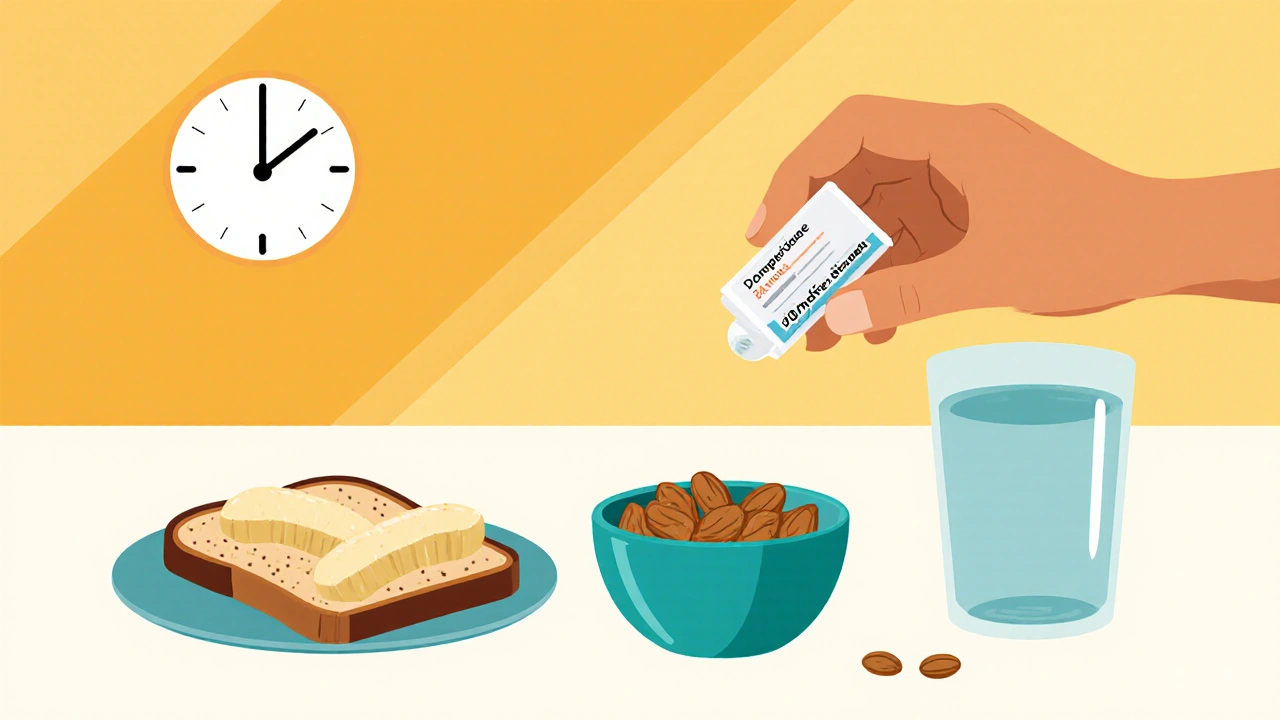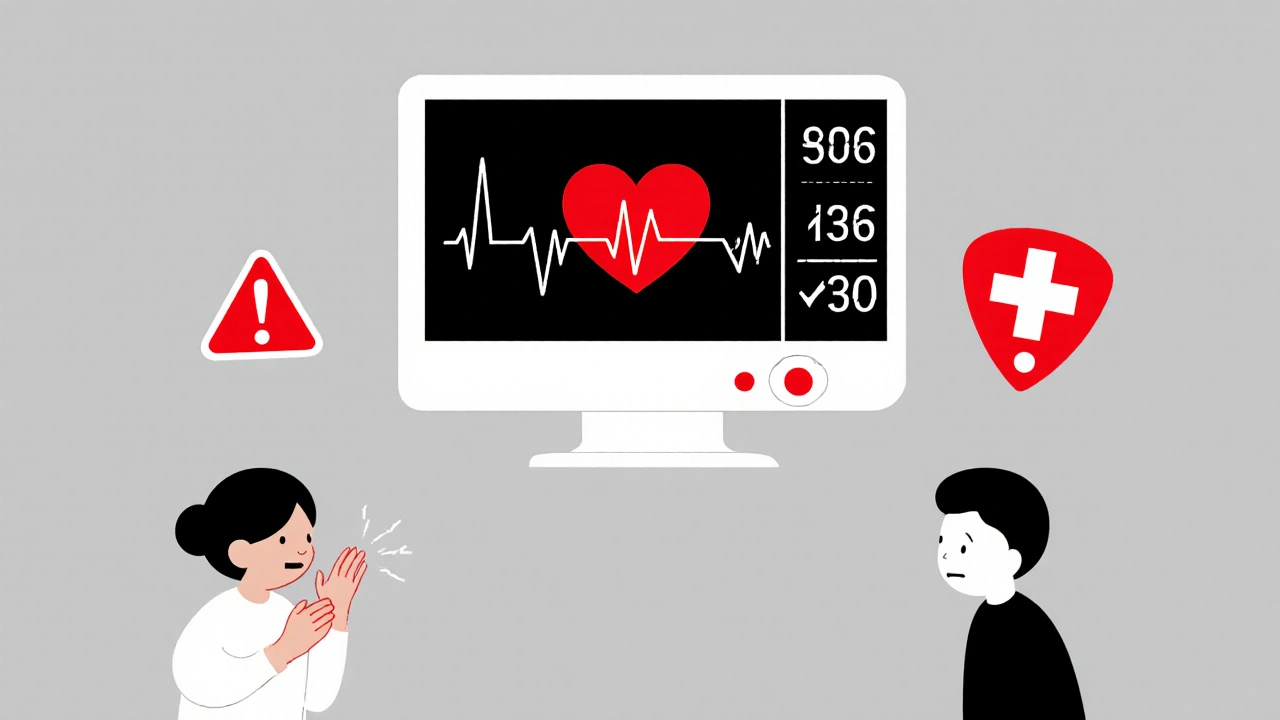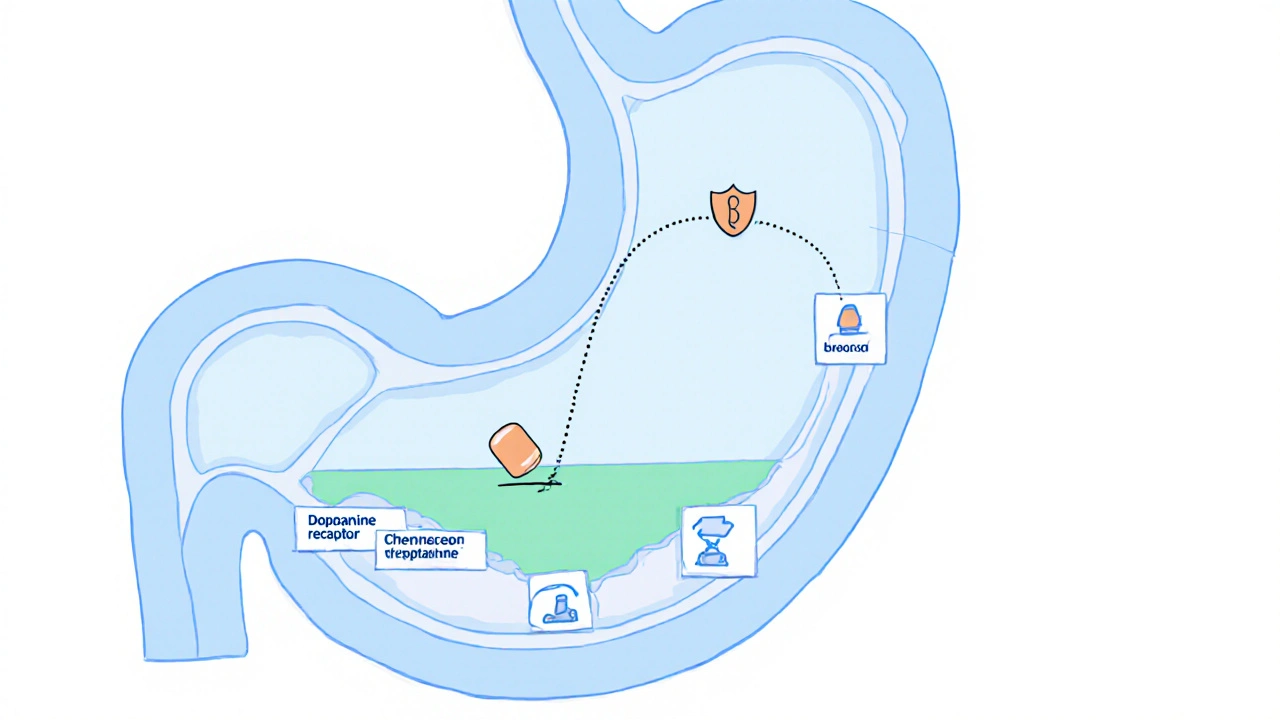Domperidone Side Effects Management Guide
This tool helps identify common side effects of Domperidone and provides practical management strategies based on your symptoms.
Quick Reference:
| Side Effect | Management Strategy |
|---|---|
| Dry mouth | Sugar-free lozenges, water, herbal tea |
| Headache | Acetaminophen (if safe), regular hydration |
| Dizziness | Take with light snack, rise slowly from sitting |
| Abdominal cramps | Small meals, avoid heavy fats, gentle walking post-meal |
| QT prolongation | Check drug list, avoid grapefruit, monitor electrolytes |
When taking Domperidone is a dopamine antagonist used to boost gastrointestinal motility and treat nausea. many people wonder how to handle the unpleasant reactions it can cause. This guide walks you through why the side effects happen and gives clear, everyday actions you can take to keep them under control.
What is Domperidone and How Does It Work?
Domperidone blocks dopamine receptors in the gut and the chemoreceptor trigger zone of the brain. By doing so, it speeds up stomach emptying and reduces the urge to vomit. The drug is often prescribed for conditions like gastroparesis, functional dyspeasia, and medication‑induced nausea.
The same dopamine‑blocking action can also affect other body systems, which is why side effects appear. Understanding this mechanism helps you target the right mitigation strategies.
Typical Side Effects You Might Experience
Not everyone gets them, but here are the most frequently reported reactions:
- Dry mouth
- Headache
- Dizziness or light‑headedness
- Constipation or, paradoxically, diarrhea
- Upper‑abdominal cramps
- QT interval prolongation - a heart rhythm change that can be serious in rare cases
These symptoms are often mild and fade as your body adjusts, but they can be bothersome enough to affect daily life.
Why Do These Side Effects Occur?
The root causes fall into three buckets:
- Pharmacology: By blocking dopamine, domperidone can interfere with the autonomic nervous system, leading to dry mouth, dizziness, and heart‑rate changes.
- Drug Interactions: Domperidone is metabolised mainly by the liver enzyme CYP3A4. Medications that inhibit CYP3A4 (e.g., certain antifungals, macrolide antibiotics, or grapefruit juice) raise domperidone levels, upping the risk of QT prolongation.
- Patient Factors: Age, existing heart conditions, electrolyte imbalances, and kidney function all influence how strongly you feel the side effects.
Knowing which factor is at play lets you tailor the right fix.

Practical Tips to Reduce Domperidone Side Effects
Below are bite‑size actions you can start today.
1. Time Your Dose Wisely
Take the tablets 30 minutes before meals. This timing lets the drug hit the gut receptors before food triggers competing signals, reducing nausea and abdominal cramps.
2. Pair It with a Light Snack
A small, low‑fat snack (e.g., a piece of toast or a few crackers) can buffer the stomach lining and soften the dry‑mouth feeling.
3. Stay Hydrated, But Choose Wisely
Drink plenty of water throughout the day, but avoid caffeinated or carbonated drinks right after dosing, as they can heighten dizziness.
4. Split the Daily Dose
If you’re on a higher total daily dose, ask your doctor whether dividing it into smaller, more frequent doses helps smooth out peaks that cause QT prolongation.
5. Watch Your Electrolytes
Low potassium or magnesium can magnify heart‑rhythm issues. Include potassium‑rich foods (banana, avocado) and magnesium‑rich foods (almonds, spinach) in your meals.
6. Check for Interacting Medications
Make a list of all prescription and over‑the‑counter drugs you take. Metoclopramide, another dopamine antagonist, can stack the side‑effect burden. Likewise, drugs like Haloperidol also prolong QT and should be avoided together.
7. Limit Alcohol and Grapefruit Juice
Both can interfere with CYP3A4, pushing domperidone levels higher than intended.
8. Use Symptom‑Relief Aids When Needed
For dry mouth, sugar‑free lozenges or sipping warm herbal tea can be soothing. If you get a headache, a mild acetaminophen dose (if not contraindicated) works well.
Lifestyle Strategies That Complement Medication
Medication tricks are only part of the puzzle. Your day‑to‑day habits matter too.
- Gentle Movement: Light walking after meals encourages gastric emptying, reducing nausea.
- Stress Management: Stress spikes dopamine, potentially worsening side effects. Try deep‑breathing or short meditation breaks.
- Sleep Hygiene: Aim for 7‑8 hours of uninterrupted sleep. Poor sleep can heighten dizziness and headache.

When to Seek Medical Help
Most side effects are manageable, but some signals demand immediate attention:
- Palpitations, fainting, or a racing heart - possible QT prolongation.
- Severe, persistent vomiting that leads to dehydration.
- Sudden confusion or visual disturbances.
If any of these appear, contact your GP or head to the nearest emergency department.
Quick Reference Table
| Side Effect | Likely Cause | Practical Management |
|---|---|---|
| Dry mouth | Dopamine blockade in salivary glands | Sugar‑free lozenges, water, herbal tea |
| Headache | Vasodilation from altered neurotransmitters | Acetaminophen (if safe), regular hydration |
| Dizziness | Blood‑pressure dip after dose | Take with a light snack, rise slowly from sitting |
| Abdominal cramps | Increased gut motility | Small meals, avoid heavy fats, gentle walking post‑meal |
| QT prolongation | High plasma levels + interaction with CYP3A4 inhibitors | Check drug list, avoid grapefruit, monitor electrolytes, ECG if risk factors present |
Frequently Asked Questions
Can I take domperidone with over‑the‑counter antacids?
Most antacids don’t interfere with domperidone, but alkaline antacids can reduce its absorption. Take domperidone at least two hours before or after an antacid to be safe.
Is it safe to use domperidone for more than two weeks?
Short courses (up to 14 days) are typical for nausea. Longer use may increase heart‑rhythm risks, especially in older adults. Always follow your doctor’s monitoring plan.
What food should I avoid while on domperidone?
Skip grapefruit and large amounts of citrus juice, as they inhibit CYP3A4. Also limit fatty meals right before the dose; they can delay drug absorption.
My child was prescribed domperidone - do side effects differ?
Children can experience the same side effects, but dosage is weight‑based, making toxicity less common. Still watch for excessive sleepiness or unusual heart rhythm.
Should I stop domperidone if I feel a mild headache?
A mild headache is a common, usually harmless side effect. Try the hydration and acetaminophen tips first; only stop if headaches become severe or persistent.


Written by Felix Greendale
View all posts by: Felix Greendale